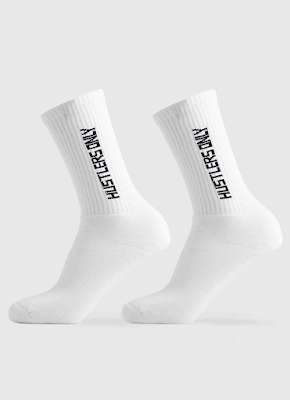The Importance of Choosing the Right Socks for Your Gym Workouts
In the realm of fitness, every detail matters, even down to the socks you wear during your gym sessions. While socks might seem like a minor component of your workout attire, they play a crucial role in ensuring comfort, performance, and foot health during exercise. In this comprehensive guide, we will delve into the significance of selecting the appropriate gym workout socks, addressing questions like which socks pair best with gym trainers, whether it's acceptable to workout barefoot, and the necessity of specialised gym socks.
The Foundation: Why Socks Matter in Gym Workouts
Socks act as a barrier between your feet and the shoes, absorbing sweat, reducing friction, and providing cushioning and support. During high-intensity workouts, such as weightlifting, running, or plyometrics, your feet endure significant stress and movement. The right pair of socks can help prevent blisters, calluses, and discomfort, enabling you to focus fully on your training.
Socks and Gym Trainers: A Perfect Match?
The choice of socks to wear with gym trainers is pivotal for an optimal workout experience. Gym trainers, designed with breathability, stability, and support in mind, require socks that complement these features. Opt for moisture-wicking socks made from materials like polyester, nylon, or a blend of synthetic fibers. These fabrics effectively wick moisture away from your skin, keeping your feet dry and reducing the risk of blisters and fungal infections.
Additionally, consider the thickness of the socks. Thicker socks provide extra cushioning and can be beneficial for activities involving impact, such as running and jumping. However, for weightlifting or activities where you need to feel grounded, thinner socks may be preferable as they offer a closer connection to the ground and enhance stability.
When selecting socks to wear with gym trainers, prioritize comfort, breathability, and moisture management to optimize your workout performance.
The Debate: Working Out Barefoot vs. Wearing Socks
Working out barefoot has gained popularity in recent years, with proponents advocating for improved balance, foot strength, and proprioception. While some gyms permit barefoot training in designated areas, it's essential to consider the potential risks and limitations.
Exercising barefoot exposes your feet to bacteria, fungi, and other pathogens present on gym floors. Moreover, without proper arch support and cushioning, you may experience discomfort and strain, particularly during high-impact activities.
While socks provide a protective layer against these hazards, they may not offer the same level of stability and support as athletic shoes. However, if you prefer the sensation of barefoot training, opt for grip socks designed specifically for fitness activities. These socks feature silicone or rubber grips on the soles to enhance traction and stability, reducing the risk of slips and falls.
Ultimately, the decision to work out barefoot or in socks depends on personal preference, comfort, and the specific demands of your workout routine.
Specialized Gym Socks: Are They Necessary?
In the ever-expanding market of athletic apparel, specialized gym socks have emerged as a popular choice among fitness enthusiasts. These socks boast features tailored to the demands of intense workouts, including targeted cushioning, arch support, seamless construction, and moisture-wicking properties.
While specialized gym socks offer advantages in terms of comfort and performance, they may not be essential for every gym-goer. Traditional athletic socks made from high-quality materials can provide similar benefits at a more affordable price point.
However, if you frequently engage in vigorous exercise or struggle with foot-related issues like plantar fasciitis or Achilles tendonitis, investing in specialized gym socks may be worthwhile. These socks can enhance comfort, reduce fatigue, and mitigate the risk of common foot ailments, allowing you to train harder and longer with confidence.
Conclusion
In conclusion, selecting the right socks for your gym workouts is a decision that should not be overlooked. From enhancing comfort and performance to safeguarding foot health, socks play a vital role in your overall fitness experience. When choosing white training socks to wear in the gym, prioritize factors such as material, thickness, breathability, and support to ensure optimal comfort and functionality.
Whether you prefer the support of specialized gym socks or the freedom of barefoot training, make an informed decision based on your individual needs and preferences. By paying attention to the details and selecting socks that cater to the demands of your workout regimen, you can elevate your gym experience and take your fitness journey to new heights.


Comments
Post a Comment